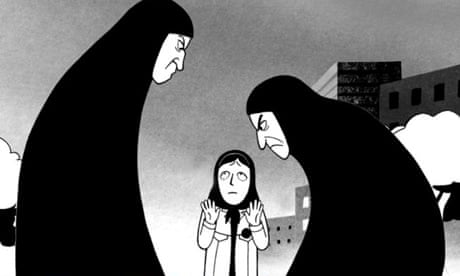I'm not proud of this but, for years and years, I thought that graphic novels were only read by geeky guys with long hair, fetid bedrooms and a serious fondness for thrash. Yes, I had read Maus by Art Spiegelman (just in case you don't know, it tells the story of Spiegelman's father, Vladek, a Polish Jew; Spiegelman draws the Jews as mice and the Nazis as cats). And I thought it was amazing, of course. But still, it seemed to me to be one of a kind. After all, graphic novels are basically comics, aren't they? And there's only so much a writer can do with a comic, and only so much pleasure a reader (at least a grown-up reader) can take in one.
But then something changed. All of a sudden, a whole slew of books came my way that made me think graphic novels could be as satisfying, and even as literary, in their way, as a regular novel. First, I read Persepolis by Marjane Satrapi, a brilliant book about growing up in post-revolutionary Iran that has become an international hit and an Oscar-nominated movie. Then, even better, Fun Home by Alison Bechdel. This book, too, tells the story of a childhood (an annoying thing about the term "graphic novel" is that it is so rarely accurate: many of the best ones are memoirs).
Bechdel grew up in an inward-looking Pennsylvanian town called Beech Creek (population: 800) in a vast Victorian house with which her father – a distant and pernickety funeral director – seemed to be madly in love. The house's interior design was somewhat rococo, being full of "astral lamps and girandoles and Hepplewhite suite chairs", and for a long while, his daughter couldn't understand it: this kind of stuff was not exactly de rigueur in Beech Creek. Then, slowly, it came to her that decorating it provided her father with some kind of release. For he was not just a lover of fine furniture; he was also, secretly, a lover of boys.
I loved reading Fun Home. It seemed to me that Bechdel had made her words count as much as her pictures. As a critic remarked in the New York Times when the book was published in 2006: "Very few cartoonists can also write. But Fun Home quietly succeeds in telling a story... through words that are equally revealing and well chosen."
After this, there was no stopping me. As it turns out, this critic was only half-right. There are tons of cartoonists who can write. If you are already a fan of comic books, you will think what I did next pretty old hat. But if you are not, I advise you to do the same, pronto. I read all the greats: Robert Crumb, of course, and then, in no particular order: Joe Matt, Seth, Daniel Clowes, Alan Moore, Adrian Tomine, Craig Thompson… oh yes, and Charles Burns (I absolutely adore Black Hole, a dystopian thriller set in 1970s Seattle, in which the city's teenagers are stalked by a sexually transmitted plague). I was in heaven! On a blog somewhere, a comic fan attacked me for being a Johnny-come-lately. But what I say is: better late than never. It's like Marjane Satrapi, who only came to comics herself at the age of 25, once said: "It's like opera: you have to go a couple of times to appreciate it."
Pretty much ever since, I've done everything I can to get graphic novels more attention: interviews with their authors, reviews of new books and, most especially, helping to organise the annual Jonathan Cape/ Observer Graphic Short Story prize, now entering its fourth great year. This has been a great success. A former winner, Julian Hanshaw, has already published his first book, The Art of Pho; another shortlisted author has since been commissioned to write his.
In 1969, John Updike, who had once thought of becoming a cartoonist himself, addressed a literary society on the so-called death of the novel. "I see no intrinsic reason why a doubly talented artist might not arise and create a comic strip novel masterpiece," he told his audience. To my ears, this now sounds oddly prescient. But what do you think? And which are your favourites?
Observer/Cape graphic short story prize
Jonathan Cape and Comica have got together with The Observer to offer you the chance to see your work in print and win £1,000.
The first prize is £1,000 and the publication of your four-page story in The Observer New Review. The runner-up will receive £250 and your work will appear on theguardian.com. The deadline for entries is 6 October 2010. To enter and read all the terms and conditions, click here











Comments (…)
Sign in or create your Guardian account to join the discussion